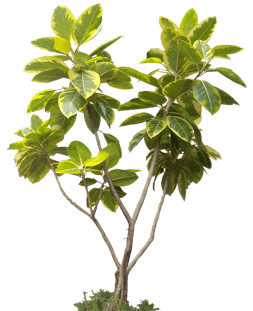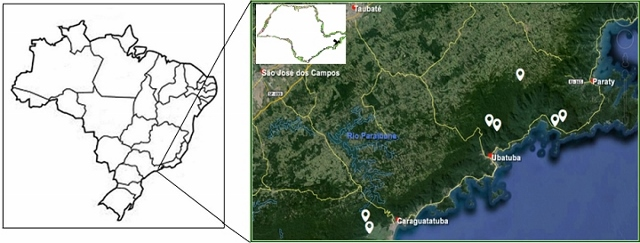PROJECT SUMMARY

Functional Gradient of Atlantic Forest History
Forests are of great importance in the current scenario of climate change, as they may contribute to the reduction of the greenhouse effect by absorbing carbon dioxide and storing this nutrient. This ecosystem service is especially important in Tropical Forests (TF) due to their high productivity, high extension (1.7 million km²) and high species diversity (Bunker et al. 2005), being considered large carbon (C) reservoirs (Malhi et al. 1999). The above ground living biomass (BAS) accounts for a significant fraction of this total C, contributing to the global nutrient cycle (Phillips et al. 1998).
The Atlantic Forest (AF) is the second largest forest in the American continent and one of the most threatened, as its fragments amount to little more than 10% of the original extent (Ribeiro et al. 2009). The available knowledge is still limited to understand how recent changes (fragmentation and climate change) interfere in the structure of processes and functioning of the AF. This knowledge is essential for the establishment of conservation, management and forest restauration actions and for the establishment of indicators for evaluating and monitoring the areas.
The Thematic Project Biota Gradient Functional (FAPESP 03/12595-7) began in 2005 with the aim of investigating, in a multidisciplinary way, the floristic composition, structure and functioning of the Atlantic Dense Ombrophilous Forest (Atlantic Forest) located in the north-eastern region of the State of São Paulo. Initially, permanent plots were established along the altitudinal gradient (0-1100 m) in the Serra do Mar State Park (Picinguaba and Santa Virgínia sites). The region was chosen due to the lack of studies focusing on floristic variations and forest structure on the escarpments of Serra do Mar. The project focused research on tree component tree diversity, ecosystem functioning, structure, dynamics, reproduction, pollination and functional attributes of the plants. In this first stage, 14 permanent plots (1 hectare each) were deployed following the RAINFOR protocol adapted by Joly et al. (2012) for the plotting, mapping and measurement of individuals with DBH ≥ 4.8 cm (diameter at breast height).
Later, the area was expanded by the Thematic Project “Population growth, vulnerability and adaptation: social and ecological dimensions of climate change in São Paulo coast” (FAPESP 08/58159-7), which included 2ha in the Caraguatatuba Nucleus, and also by the PELD/CNPq program, which included areas at 600, 800 and 1200-meters altitude (Picinguaba and Cunha Nuclei). This set of plots, known as PELD/FGAF site aims to consolidate the infrastructure and research lines implemented by the Thematic Biota Functional Gradient and, currently, has 19 permanent plots for monitoring vegetation distributed in an area of ca. 600 km² (Figure 1). Recently, with the Project “ECOFOR: Biodiversity and ecosystem functioning in areas altered by man in the Amazon and Atlantic Forests” (NERC/FAPESP 12/51872-9), the study areas expanded to a fragmentation gradient between the slopes of the Serra do Mar to the margins of the Paraiba River.
The infrastructure established by the project allows the identification of changes in the composition, structure and functioning of this biodiversity hotspot in the long term. Monitoring is important because the Atlantic Forest has higher total amounts of carbon stocked in the soil than the Amazon Forest. Thus, the AF may be more sensitive to climate change, because warming will alter decomposition rates and mobilize stored C, becoming a likely source of emission of this nutrient.
SUMMARY
The Atlantic Forest (AF) is the second largest forest in the American continent and one of the most threatened, since its fragments total little more than 10% of the original extension (Ribeiro et al. 2009). Due to this fragmentation, the high diversity of species and the very high degree of endemism, the AF is classified as a biodiversity hotspot (Myers et al. 2000). Most of the remnants are found in the State of São Paulo (Hirota 2003), where is also found the largest protected area of the MA: the State Park of Serra do Mar (PESM), where this project is being developed. The available knowledge is still limited to understand how recent changes (fragmentation and climate change) interfere in the structure of processes and functioning of the AF. This knowledge is essential for the establishment of actions for the conservation, management and recovery of the different forest physiognomies and for the establishment of indicators for evaluating and monitoring the areas. Thus, the aim of the project is to investigate in a multidisciplinary way the floristic composition, structure and dynamics of the functioning of the Atlantic Dense Ombrophilous Forest of the Caraguatatuba, Cunha, Picinguaba and Santa Virginia nuclei, PESM, São Paulo, Brazil and to compare these characteristics with smaller fragments that currently exist in private areas.
PELD/FGAF SITE (Functional Gradient of Atlantic Forest)
The establishment of this PELD site aims at consolidating the infrastructure and research lines implemented in the region through the BIOTA and Climate Change Programs of FAPESP. The site covers four nuclei of PESM: Caraguatatuba, Cunha, Picinguaba and Santa Virginia. The Picinguaba-Santa Virgínia-Cunha strand is justified by the need to cover all the phytophysiognomies that comprise the Atlantic Dense Ombrophilous Forest: Restinga Forest (Picinguaba); Lowland Dense Ombrophilous Forest (Picinguaba); Submontane Dense Ombrophilous Forest (Picinguaba); Montane Dense Ombrophilous Forest (Santa Virgínia) and High Montane Dense Ombrophilous Forest (Cunha). The inclusion of areas in the Caraguatatuba Nuclei is justified by the goal of monitoring, in the medium and long term, the possible impacts of the implementation of the Petrobrás Gas Treatment Unit (UTGCA) on the Atlantic Dense Ombrophilous Forest. Currently, the total area studied, available on a non-continuous basis, is 20 hectares of AF within the Serra do Mar State Park and 16 fragments in private properties (Figure 2).




